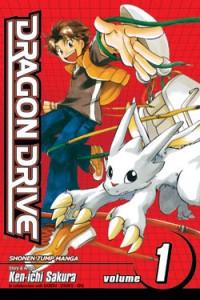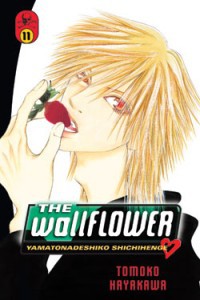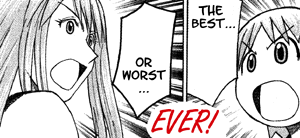RIGHT TURN ONLY!!
Kashimashi ~Boy Meets Dragon~
by Carlo Santos,

Happy Tax Day to all our American readers! But more importantly, that also means the new Pokemon Pearl and Diamond games are coming out next week. Ah ... nothing fires me up quite like electronic pretend-creature cockfighting! And the first manga on our list seems to think so too!
DRAGON DRIVE

Vol. 1
(by Ken-ichi Sakura, Viz Media, $7.99)
FROM THE BACK COVER:
"Reiji Ozora thinks he's no good at anything—especially schoolwork! Then one day he's introduced to a game called Dragon Drive and gets his very own virtual dragon called Chibi. Small and weak, Chibi appears to be as big a loser as Reiji! But after their first battle, Reiji realizes there may be more to his tiny friend than meets the eye.
Reiji and his best friend Maiko are in for the fight of their lives when they take on an experienced Dragon Drive player who boasts that he'll win the match in just 10 minutes! Once the game begins, Reiji and Maiko are quickly cornered in a construction site. Forced up a giant crane, the two friends are about to become pancakes when a tiny dragon pulls off an unbelievable feat!"
EVIDENCE FOR:
It's been a long time since anything about dragons captured my imagination (sorry folks, but Eragon is the reason teenagers shouldn't publish fantasy novels). But this ultra-modern, Anne-McCaffrey-by-way-of-Namco adventure definitely has some things going for it. It's quick to jump into the story, and even quicker to send Reiji on his first battle—you've got to love the sheer underdog appeal of a dragon named Chibi! Simple, dynamic layouts and the uptempo pace make this an surefire page-turner, and it's hard not to get caught up in the action scenes: Reiji and Chibi's daring flight off the crane, for example, or the epic battle between the #1 and #2 players in the country. There's also a lot of appeal in the dragons themselves, with a wide variety of designs drawn from all cultures. These aren't just your average fantasy-book-cover dragons—they might look mythological, or mechanical, or ghostly, or beastly, and sometimes, in the case of Chibi, they're just plain cute.
EVIDENCE AGAINST:
Ever feel like you've accidentally walked into a giant toy commercial? That's the true essence of Dragon Drive, which so overdoes it with the virtual-gaming conceit that you almost expect a pop-up window to appear and say that the Dragon Drive game is available RIGHT NOW!! (... in Japan.) The series is so overlaid with inscrutable "gamer logic" that it threatens to alienate anyone who doesn't instantly give in to this esoteric world of player rankings, arcade tournaments, and customizable swipe-cards. It's like Angelic Layer minus the heart and personality, and what it's got in place of that is a generic battle story with generic characters: the strong silent rival, the pompous blowhard, and of course, one underdog to rule them all. Also, all the behind-the-scenes rumor-mongering about Reiji's "special powers" is as annoying as it gets; just once it'd be nice to have a hero who actually succeeds through his own hard work instead of some hidden gift that pulls him out of every scrape. Watch out for the inconsistent artwork as well—for every brilliant dragon scene you'll get 15 pages of hastily drawn human characters that could have come out of anyone's old sketchpad. And they'd be the rejected character designs.
FINAL VERDICT:
If it weren't for the uptempo battles and the seriously impressive dragons, this first volume would be getting far, far less than a C.
EYESHIELD 21

Vol. 13
(by Riichiro Inagaki and Yusuke Murata, Viz Media, $7.99)
FROM THE BACK COVER:
"Wimpy Sena Kobayakawa has been running away from bullies all his life. But when the football gear comes on, things change—Sena's speed and uncanny ability to elude big bullies just might give him what it takes to become a great high school football hero! Catch all the bone-crushing action and slapstick comedy of Japan's hottest football manga!
Could there be more than one Eyeshield 21? A player on a rival team claims he met the real Eyeshield 21 while he was an exchange student in America. Back then, this mysterious other Eyeshield was on the Notre Dame feeder school football team. But now he's in Japan, and he's going to play during the fall season!"
EVIDENCE FOR:
Open up any volume of Eyeshield 21 and you will be guaranteed at least one thing: incredible artistic detail and energy. Even the backgrounds are dynamic, with buildings bending the very limits of perspective. What a town to live in! Meanwhile, the personal aspect remains strong as well, with great emotional intensity among all the players of this game. Who would have guessed that even hooligan Rui Habashira would have his moment of heartbreak? And of course, little Sena is as determined as ever—you can see it right on every line of hatching on his face. The most fascinating character, however, is the one that isn't there: the tale of the "real Eyeshield 21" is not only the best subplot in this volume, but it'll provide plenty of intrigue for future storylines. On the other hand, if it's comedy you want, the sumo-wrestling chapter is the winner here, if only because it appears to be the Japanese equivalent of that odd "Football Players Training With Ballet" meme.
EVIDENCE AGAINST:
Wow ... this volume reminded me of why I ignore the NCAA Basketball tournament until about the Final Four. This installment slogs through the middle rounds of the high school tourney, meaning lots of ho-hum matchups with teams and players nobody cares about. Even the ones with familiar or amusing characters—like Deimon's game against Dokubari (sheh heh heh!)—are rushed through in a single chapter, making them more like chores rather than exciting matchups. And if it's not boring football, then it's boring conversation; over and over, we're going to hear Sena talk about how determined he is and how Kyoshin's team is unbeatably tall. ("Man! Kyoshin's team is so unbeatably tall! I'm gonna try my best." - not an actual quote.) Apparently, this segment of the series is so starved for plot that one Deimon player even runs away from the team for an entire chapter, providing a handy distraction that eats up 20 more pages. Worse yet, the humor isn't as sharp as it's been in the past. What you get in the end is a volume that accomplishes nothing except hyping everyone up for the Deimon-Kyoshin game ... to be played in Volume 14.
FINAL VERDICT:
Although this is still a fun, exciting series, Vol. 13 has to be one of the weakest ones yet, a space-filler and time-killer that only deserves a C.
KASHIMASHI ~GIRL MEETS GIRL~

Vol. 2
(by Satoru Akahori and Yukimaru Katsura, Seven Seas, $10.99)
FROM THE BACK COVER:
"Thanks to a freak accident involving an alien spaceship, poor Hazumu has been irreversibly transformed into a girl. Now the former teenage boy gets caught in the middle of an all-girl love triangle, with childhood friend Tomari and first love Yasuna vying for his/her romantic attentions.
When Tomari unintentionally witnesses a kiss between Yasuna and Hazumu, her long-suppressed feelings for Hazumu come bursting to the surface along with Hazumu's childhood promise to become her 'groom.' But with summer vacation starting and Tomari stuck in training camp, it's going to be harder than ever for her to keep her love rival Yasuna in check. Watch as sparks fly in this second installment of an altogether transformative romance!"
EVIDENCE FOR:
The arc of this volume is something beautiful, a perfect mathematical curve: it picks up where Vol. 1's dramatic ending left off, sweeps through a sine-wave of changing relationships, and finishes with Tomari making a dramatic statement of her own. Emotional rides don't get much better than this one—just when you think Hazumu's got it figured out with one girl, here comes the other one! As Tomari and Yasuna's intentions grow stronger, so does the tension level, promising plenty of yuri-scented angst in the pages to come. Fortunately, Hazumu's alien pals are still around to lighten the mood, providing moments of comedy in between all the drama. Hazumu's manly-man best friend and his newfound attraction to "her" is also played for laughs, balancing out the more serious relationships. When it's time for a heart-to-heart, though, this series pulls out all the stops—look at the expressive layouts in any scene that involves hand-holding or one-on-one conversation. Clearly, where you put the pictures matters just as much as the words you say. In fact, the delicate artwork is so sure-handed that even moments of fanservice reach a higher aesthetic plane. Now that's real talent.
EVIDENCE AGAINST:
Too much yuri-scented angst just stinks up the place. With emotions running high, you're going to get plenty of cheesy melodrama in this volume, with flashbacks and symbolism galore. Of course Hazumu is indecisive, but how many more times are we going to have to see her standing between Tomari and Yasuna, or trying to pick between two objects, or ... get the point? Well, you'd better get the point, after seeing it multiple times in every chapter. And sometimes the chapters themselves don't have anything else interesting going on—this volume sees an obligatory run of summer activities, including a beach trip, a courage test, and a matsuri. So it is that the middle portion feels weak compared to the emotionally powerful beginning and ending: Hazumu and Tomari do something sweet, then Hazumu and Yasuna go out, then Hazumu's teacher nearly kills herself again, repeat as necessary. Forget repetition—let's see those relationships grow, not circle around!
FINAL VERDICT:
It's sweet, it's dramatic, it's a bit boring at times, but the lives of these characters are fascinating enough to earn a B.
SHUGO CHARA!

Vol. 1
(by Peach-Pit, Del Rey, $10.95)
FROM THE BACK COVER:
"Everybody at Seiyo Elementary School thinks that stylish and super-cool Amu has it all. But nobody knows the real Amu, a shy girl who wishes she had the courage to truly be herself. Changing Amu's life is going to take more than wishes and dreams—it's going to take a little magic! One morning, Amu finds a surprise in her bed: three strange little eggs. Each egg contains a Guardian Character, an angel-like being who can give her the power to be someone new. With the help of her Guardian Characters, Amu is about to discover that her true self is more amazing than she ever dreamed."
EVIDENCE FOR:
While a girl and some magic are clearly involved in Shugo Chara, this is hardly the average magical-girl formula: instead it probes the human psyche, asking questions about the true self versus the self that's presented to others. For added conflict, let's throw in that mainstay of youth fiction: the popular girl who's actually insecure, which is basically Amu in a nutshell. Of course, this isn't the first time Peach-Pit has tackled issues of alienation and fitting in at school—hello, Rozen Maiden—but Amu is a more accessible character, and an intriguing heroine because she's neither the perfect sweetheart nor a complete klutz. The series' sharp attitude also sets it apart—Amu gets grumpy and is known to talk back, which is pretty refreshing in a genre full of mega-polite schoolgirls, and the supporting cast has its own set of quirks too (like "kingly" Hotori and overly friendly Nadeshiko). Visuals also go a long way in providing the series' appeal, achieving a perfect blend of cute and cool. It screams of shoujo, but in a good way, with confident lines and stylish character designs.
EVIDENCE AGAINST:
This series would be fantastic ... if it didn't start turning into the very thing it's supposed to transcend. It doesn't take more than a few chapters before the focus shifts from Amu's individual self-discovery to some kind of magical quest. Naturally, this quest requires the help of the Guardian Characters. And naturally Amu, having three of them, is some kind of Chosen One. It's disappointing, because there's so much potential in seeing Amu deal with genuine personal issues—finding an identity and making friends—and instead it just backslides into this whole "Hey, here's some magic powers, now find the special jewel" mumbo-jumbo. It doesn't help that the villains she's competing against are poorly developed; it's like these shadowy bad guys are just trying to look menacing because that's what shadowy bad guys do. Meanwhile, backgrounds are the biggest weakness in the art department, going overboard with patterns and speedlines.
FINAL VERDICT:
Just think: if it had gone the thoughtful-school-drama route instead of the magical-fantasy-quest route, it might be sitting on something higher than a B-. (But also, it wouldn't sell as much.)
THE WALLFLOWER

Vol. 11
(by Tomoko Hayakawa, Del Rey, $10.95)
FROM THE BACK COVER:
"Determined to turn goth loner Sunako into a lady, and frustrated by their lack of progress, the guys persusade a reluctant Kyohei to take Sunako out on her first date. Now they just have to convince Sunako, who equates dating with suicide. The guys trick Sunako by promising her VIP seats at a pro-wrestling death match (the operative word being "death"). The possibility of seeing blood spilled really gets Sunako excited. What's more, she even lets Kyohei take her out afterward to a horror flick and a delicious dinner. But wait ... dinner and a movie ... that almost sounds like a ... Noooooooooooo!"
EVIDENCE FOR:
Yessssss! It's hard to believe that it's taken 11 volumes to get to a date chapter, but it's totally worth it, as the ensuing hilarity brings out the best in both Sunako and Kyohei. Looks like there's a soft spot behind that cold-hearted exterior after all, even if she expresses it by helping Kyohei beat up a gang of thugs. (Somehow, their tag-team fighting is unbelievably cute—just trust me on this.) Even funnier is when Sunako squirms at the sight of "traditional" couples engaging in flowery, twinkly schmaltz ... ah, so nice to see shoujo romance getting a poke in the face. The previous chapter where she befriends the school wimp has its moments too, as for the first time we meet a character that matches Sunako's personality. He's a refreshing break from the quadruple bishounen overload, and his sheer incompetence is endearing. Meanwhile, running gags like Sunako's nosebleeds and her love of the macabre continue to be funny, mostly by virtue of pinpoint timing—you know it's coming, but you laugh because it's so true.
EVIDENCE AGAINST:
How is it that any manga-ka can get away with such lazy art? If this were the work of some Joe Schmoe Amerimanganese wannabe, they would be FIRED. We're looking at characters that are impossible to tell apart, no backgrounds half the time, and shortcut chibi drawings popping up all over the place. It's definitely a step back from Vol. 10, which had some pretty cool action scenes; this time the only glimmer of hope is the fight in the date chapter. Maybe Tomoko Hayakawa's lingering bad mood, so carefully detailed in the author's notes, had something to do with it? Perhaps that also explains the lackluster chapters in the first half of the book: the first one features two of the boys' girlfriends, who turn out to be the most uninteresting girly-girls ever (clearly there's a reason why they're side characters), and the second starts out promising—looking into Sunako's fascination with her anatomical doll Hiroshi—but eventually becomes just an excuse to show Kyohei with his shirt off. But hey, for some people that's actually a plus.
FINAL VERDICT:
It seems that this volume is all about balance—some pretty good chapters balanced out by some pretty bad ones (and Hayakawa's negative waves). Take the average and it's a D+ at best.

AVRIL LAVIGNE'S MAKE 5 WISHES

Vol. 1
(by Camilla d'Errico and Joshua Dysart, Del Rey, $12.95)
FROM THE BACK COVER:
"Hana just doesn't fit in. At school, she feels like the invisible girl. ('No. Not invisible. Being invisible would've been cool. I just wasn't worth noticing.') At home, she avoids her parents' arguments by retreating to her bedroom, where she spends hours online, assuming various cool, smart, sexy and popular alter egos and kicking back with her all-time idol and very best (though only in her imagination) friend, rebel rocker Avril Lavigne. One night Hana runs across a mysterious website called Make5Wishes.com. Somehow, she can't click away—and before she knows it she's ordered a package guaranteed to make dreams come true. Will it end up being a Pandora's box? It all depends on the lovable but wily demon inside. Is Hana sure she knows what she wants? And does she know that what you want can be very different from what you get?"
EVIDENCE FOR:
There is a myth, perpetuated by certain publishers and parroted by artists-in-training, that your "manga" is not "pro" unless it's been inked and toned to within an inch of its life. This generally results in stiff, ugly visuals resembling a well-polished turd. Make 5 Wishes sidesteps all that with one daring move: full color over pencil outlines. The end result is vibrant yet subtle—pencil lines create the feeling of organic, living artwork, not frozen into place by ink, while gradient colors avoid the harshness of screentone. The story is surprisingly subtle as well, creating a "magical slice-of-life" mood where troubled emotions take center stage. In a way, it's almost disturbing how close to home it hits on issues of modern youth: alienation, identity, celebrity worship, screwing around on the internet (aren't we all too familiar with that one). Seamless layouts help with the subtlety as well, able to create moods with just a few well-placed panels. And while the later half shifts into a familiar Monkey's Paw scenario, the wish-granting demon's unpredictability adds an element of suspense, and creates a feeling that hasn't been felt in a long time: wanting to read Volume 2 and see what happens next.
EVIDENCE AGAINST:
Why the celebrity tie-in, WHY GOD WHY?! It doesn't matter how good the story is—it'll be forever tainted by that showbiz stench that calls to mind Courtney Love, Morning Musume and the Wu-Tang Clan. In fact, the idea of having a famous imaginary friend as a psychological escape works just fine without some guitar-wielding pop tart showing up and piggybacking on it to hawk her latest album. Ugh! Seems like that whiny rebel music has been getting to Hana as well, as the book is often dominated by her self-pitying internal monologue. This isn't subtlety; it's emo. (And I don't really care what the "proper definition" of emo is, because nobody ever uses the "proper definition" of manga either, anyway.) But hey, if sad prepubescent girls turn your crank, go for it. Just watch out for the shapeshifting art; it's a cool style, but suffers from irregularities—character designs and linework will suddenly turn sloppy from one page to the next. A little consistency checking, please?
FINAL VERDICT:
Bandwagon-jumping pop-rockers aside, the subtle mood and artistic technique of this work are sure to pull you into the realms of Hana's mind—if you give it a chance.

It's the start of the spring TV season in Japan, and that means new shows galore! If you're only watching the anime airwaves, though, you're going to miss the screen adaptation of one of the Best Manga I've Ever Read:
SEXY VOICE AND ROBO

(by Iou Kuroda, Viz Media, $19.99)
It's very important to talk about Sexy Voice and Robo right now. Not only because the live-action drama is starting this month, but also because it's a fantastic little series that ended way too soon (2 volumes in Japan, packaged as one in the US). If you missed the full length review from way back when, here's the quick version: Nico Hayashi is a capricious 14-year-old who spends her free time pretending to be a phone dating service and taking calls from "clients." Because of her ability to read people and adapt to any conversation, she's nicknamed "Sexy Voice," and when she teams up with a twentysomething otaku by the name of "Robo," they become an unstoppable special-agent duo, going on covert urban missions under the auspices of a mentor simply known as "the old man."
From here it's an absolute tour de force of the imagination—anything can happen, and usually anything does happen, whether it's stopping a terrorist attack at a soccer game, saving a software engineer's livelihood, or solving a tricky assassination. But some of Sexy Voice's finest moments are when the story looks inward, into what makes these enigmatic characters tick: when the old man meets his former lover, or when Nico ponders a future career as a spy, it's got as much heart as any melodrama out there, and usually more sophisticated, too. And because Kuroda is so imaginative, these plotlines wind around each other in the most fascinating ways. If you find yourself complaining that manga is too predictable, then here's the opposite of predictable, where you just have to keep reading because you never know if something from Chapter 2 might suddenly pop up in Chapter 7. Then there's the bold, brushy artwork, which is the final clincher—it might look "sloppy," it might look "weird," but damn if it isn't full of emotion and passion. If there's any title that truly deserves to be called unique, it's this one.
And the other reason to check it out:

SUZUKA OHGO!!
discuss this in the forum (18 posts) |